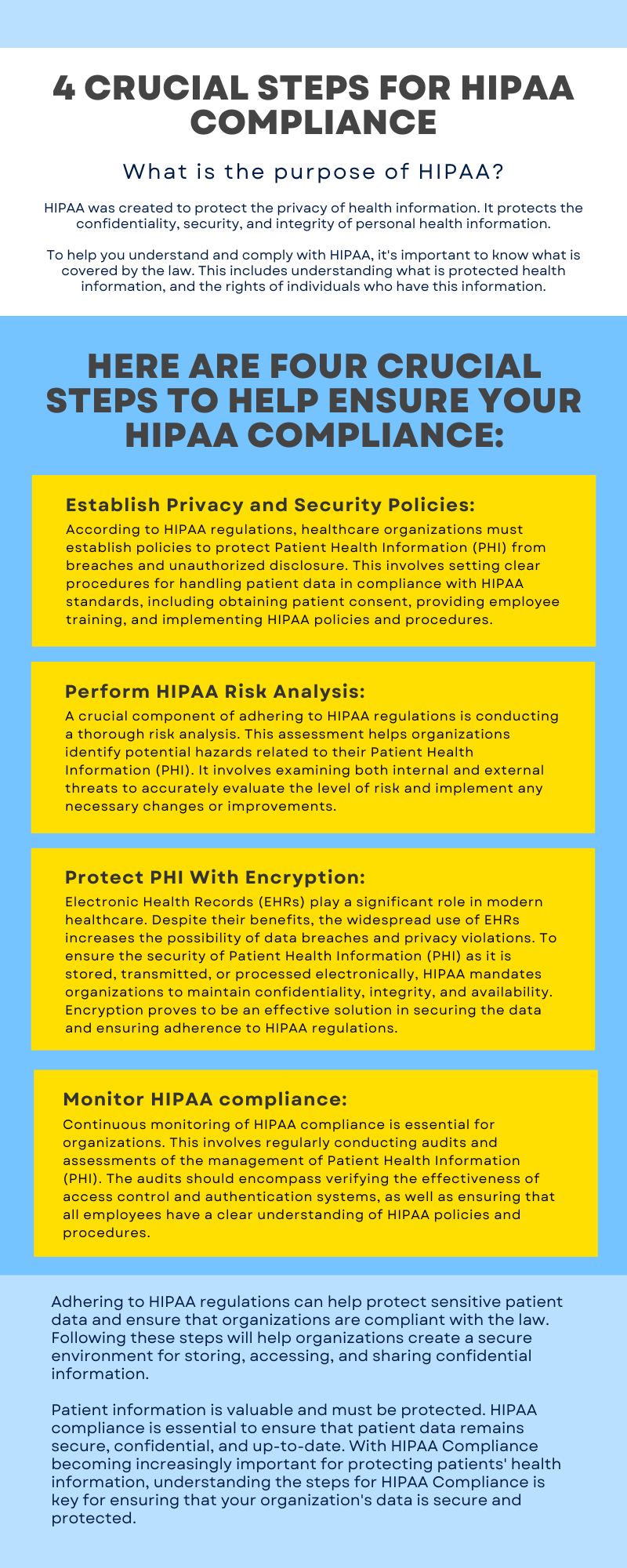
Table of content
All companies that handle or process health information need to be HIPAA-compliant. With security breaches and data leakages becoming increasingly common, this requirement becomes even more pressing. HIPAA compliance protects patient privacy, which is paramount in healthcare.
HIPAA or the Health Insurance Portability and Accountability Act of 1996 is a law that provides data privacy and security provisions for safeguarding medical information. HIPAA compliance is the process of ensuring that organizations adhere to HIPAA regulations, rules, and guidelines.

HIPAA is a landmark healthcare legislation that was created to protect the privacy of health information. It sets standards for protecting the confidentiality, security, and integrity of personal health information.
To help you understand and comply with HIPAA, it’s important to know what is covered by the law. This includes understanding what is considered protected health information, as well as the rights of individuals who have this information.
Here are four crucial steps to help ensure your HIPAA compliance:
HIPAA requires healthcare organizations to have policies in place related to safeguarding PHI from potential breaches or unauthorized disclosure. You must establish clear procedures on how you will handle patient data according to HIPAA standards, including patient consent forms, employee training programs, and HIPAA policies and procedures.
These policies and procedures should include guidelines for how PHI is accessed, stored, used, shared, transmitted, and destroyed to ensure that it remains secure at all times. You should also provide training to staff on HIPAA policies and make sure everyone understands their responsibilities when it comes to HIPAA compliance.
One of the most important aspects of HIPAA compliance is performing a comprehensive risk analysis. This process helps organizations identify potential risks associated with their protected health information (PHI). Organizations should analyze external and internal threats to thoroughly assess their level of risk and make any necessary changes or modifications.
This step involves assessing the potential risks of PHI falling into the wrong hands, either through unauthorized access or a data breach. You must assess both physical security and electronic security, as well as look at any third parties who may have access to PHI.
Electronic health records (EHRs) are an important part of healthcare today. However, with their increasing popularity comes the risk of data breaches and privacy violations. HIPAA requires organizations to protect the confidentiality, integrity, and availability of PHI as it is stored, transmitted or processed electronically. Encryption is a powerful tool that can be used to secure data and make sure HIPAA compliance is maintained.
It’s important to ensure that all employees understand HIPAA rules and regulations, as well as their role in helping maintain HIPAA compliance. HIPAA training should include an understanding of HIPAA requirements such as access control and authentication protocols for electronic health records (EHRs). It should also cover topics such as identity theft protection, data breach notification laws, and other security risks related to PHI.
Organizations should have a process in place to monitor HIPAA compliance on an ongoing basis. This includes completing routine audits and reviews of how PHI is managed. Audits can include checking to make sure that access control and authentication systems are functioning properly, as well as confirming that all employees understand HIPAA policies and procedures.
By following these steps, organizations will be better able to ensure HIPAA compliance in the handling of protected health information (PHI). Organizations must also remain vigilant, by continually monitoring HIPAA compliance as new technologies develop and security threats evolve. With careful planning and oversight, organizations can protect sensitive PHI while maintaining HIPAA compliance at every step.
HIPAA standards are complex and ever-evolving, but following a few key steps can help you stay compliant:
Designate a HIPAA Security Officer. This person will be responsible for monitoring HIPAA compliance and should receive training to understand HIPAA requirements, rules and regulations.
Create and enforce policies that comply with HIPAA standards. Policies should cover areas such as data access control, employee training regarding handling of sensitive data, information system security measures, and disaster recovery plans.
Implement an effective risk assessment program to identify any potential breaches or weaknesses in the current system. Risk assessments must be conducted regularly, and any risks identified must be addressed promptly.
Invest in HIPAA-compliant security tools such as firewalls, encryption technology, authentication systems, data loss prevention software and antivirus protection.
Educate employees about HIPAA regulations and best practices for handling confidential information. Provide training sessions to ensure that everyone understands their responsibilities under HIPAA.
Regularly review HIPAA compliance. This includes ongoing monitoring of the system to make sure that all HIPAA requirements are being met and any changes required are made promptly.
Develop an incident response plan to deal with potential breaches or other HIPAA violations quickly. This should include guidelines for investigating the breach and any corrective measures that need to be taken, as well as notification of the appropriate authorities.
Adhering to HIPAA regulations can help protect sensitive patient data and ensure that organizations are compliant with the law. Following these steps will help organizations create a secure environment for storing, accessing, and sharing confidential information.
Patient information is valuable and must be protected. HIPAA compliance is essential to ensure that patient data remains secure, confidential, and up-to-date. With HIPAA Compliance becoming increasingly important for protecting patients’ health information, understanding the steps for HIPAA Compliance is key for ensuring that your organization’s data is secure and protected.
Table of content